ISSN ONLINE(2319-8753)PRINT(2347-6710)
ISSN ONLINE(2319-8753)PRINT(2347-6710)
Vidyadhar Deshpande1, Arvind Dhekhane2
|
| Related article at Pubmed, Scholar Google |
Visit for more related articles at International Journal of Innovative Research in Science, Engineering and Technology
In this paper contact stress analysis of kiln tyre is presented. Contact stress plays key roll in pitting of tyre. In some cases, contact stress cause cracks in tyre. Highest value of contact stress is not on the surface but slightly below. Tyre is supported by rollers, contact pattern arrangement of tyre and roller is similar to two cylinders in contact and axes are parallel. Load on tyre is calculated considering kiln is simply supported. Contact stress analysis is performed using analytical and finite element simulation.
Keywords |
| Cement kiln, Tyre, Contact stress, Reactions. |
INTRODUCTION |
| Rotary kiln is widely used in processing industries, such as cement, ore processing and chemical. The kiln is a cylindrical shell slightly inclined to the horizontal position and supported by tyres. A Girth gear and pinion assembly rotates the entire system. Material enters the kiln at the upper end and moves to words the lower end. With continuous mixing and a supply of hot air the desired chemical reaction is completed at the lower end and thus the processing is continuous. The kiln shell has a fire brick lining to protect the outer steel shell from the high temperatures existing inside. The tyre is a cylindrical ring supporting to the kiln shell. Tyre is cylindrical cast or forged single ring. Following picture gives general arrangement of tyre and rollers. |
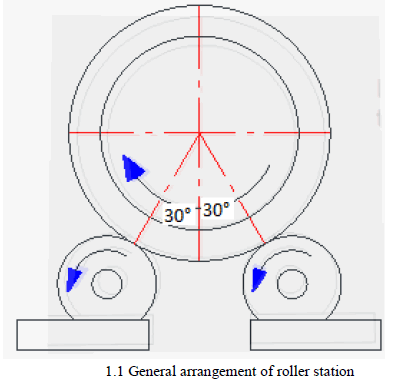 |
II. LOAD ON TYRE AND ROLLERS |
| Kiln shell is loosed fitted in kiln tyre and can be treated as simply supported beam. Kiln inlet and kiln outlet do not support kiln shell. To calculate reaction at tyre following loads are considered. A. Refractory load: |
| Kiln is very long and different chemical processes occur at different locations. Temperature inside the kiln vary from point to point, it is higher in burning zone and reduce toward kiln inlet. Kiln is mainly divided in three zones inlet zone, transition zone and burning zone. Three types of bricks having different density are used in these zones. Refractory load is calculated considering quality of refractory and zone length. B. Point loads: Girth gear, inlet seal and outlet seal are mounted on the kiln shell. Weight of these components is considered as point loads at that position. Point loads: Girth gear, inlet seal and outlet seal are mounted on the kiln shell. Weight of these components is considered as point loads at that position. C. Coating load: Due to chemical process material coating is formed inside of kiln. Weight of Coating is taken by kiln shell. D. Material filling load: In process kiln is filled 5-10% in inlet and transition zone and 8-15% in burning zone. Load of material filling is taken by kiln shell. E. Self weight: Load due to kiln shell itself. Considering above loads is symmetrically distributed about vertical axis of kiln. This mean that loads are equally distributed on each roller in a pair. Reactions at three tyres are calculated by STAAD software and Reactions are as shown in fig. 2.2 |
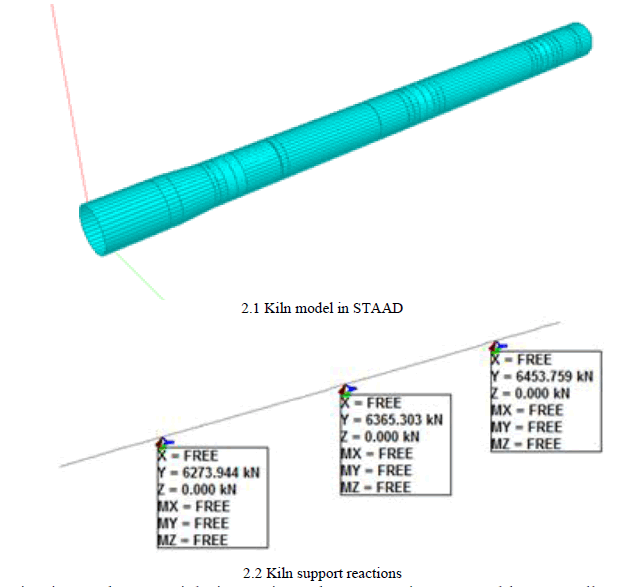 |
| The maximum reaction is 6454kN & weight is tyre is 680kN. A tyre is supported by two rollers. Angle between tyre and roller is 30 degree. Load between roller and tyre is 4119kN. |
III. TYRE & ROLLER CONTACT STRESS CALCULATION BY ANALYTICAL METHOD |
| When two bodies having curved surfaces are pressed together, point or line contact changes to area contact, and the stresses developed in the two bodies are three dimensional. Typical failures are seen as cracks, pits, or flaking in the surface material. |
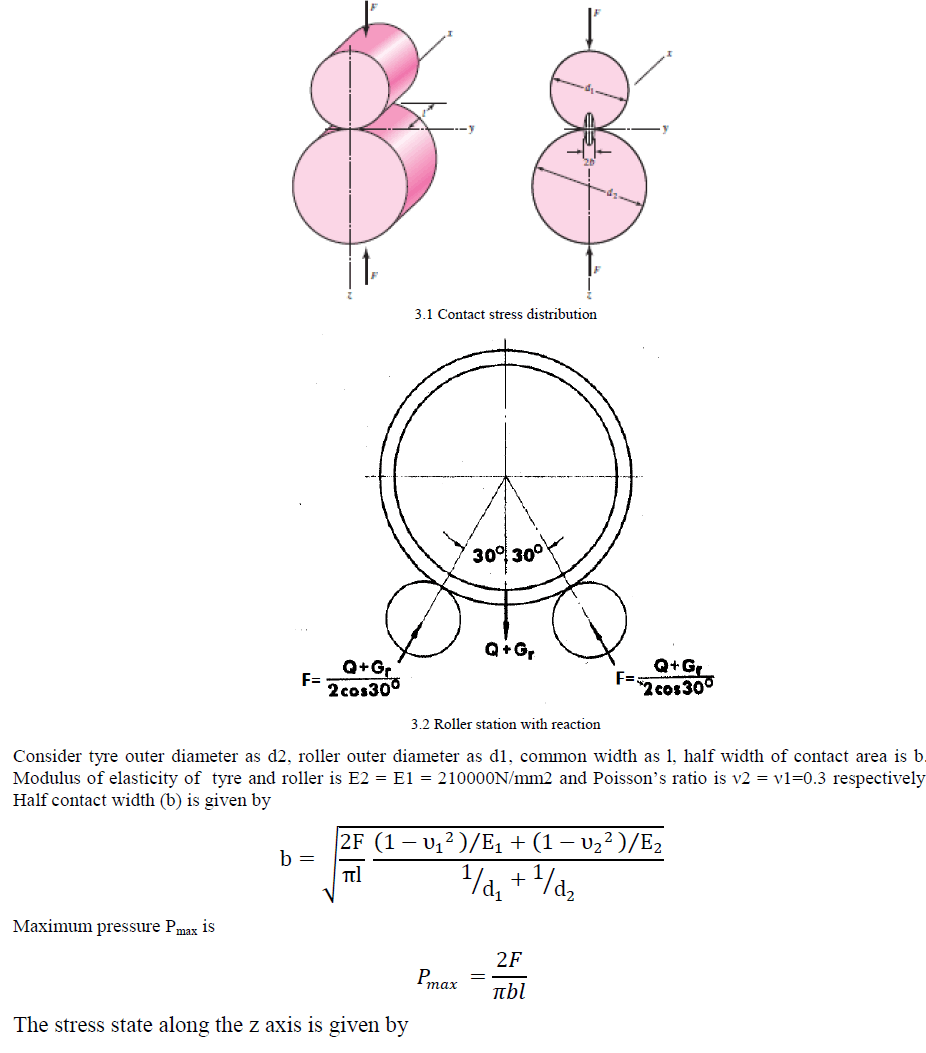 |
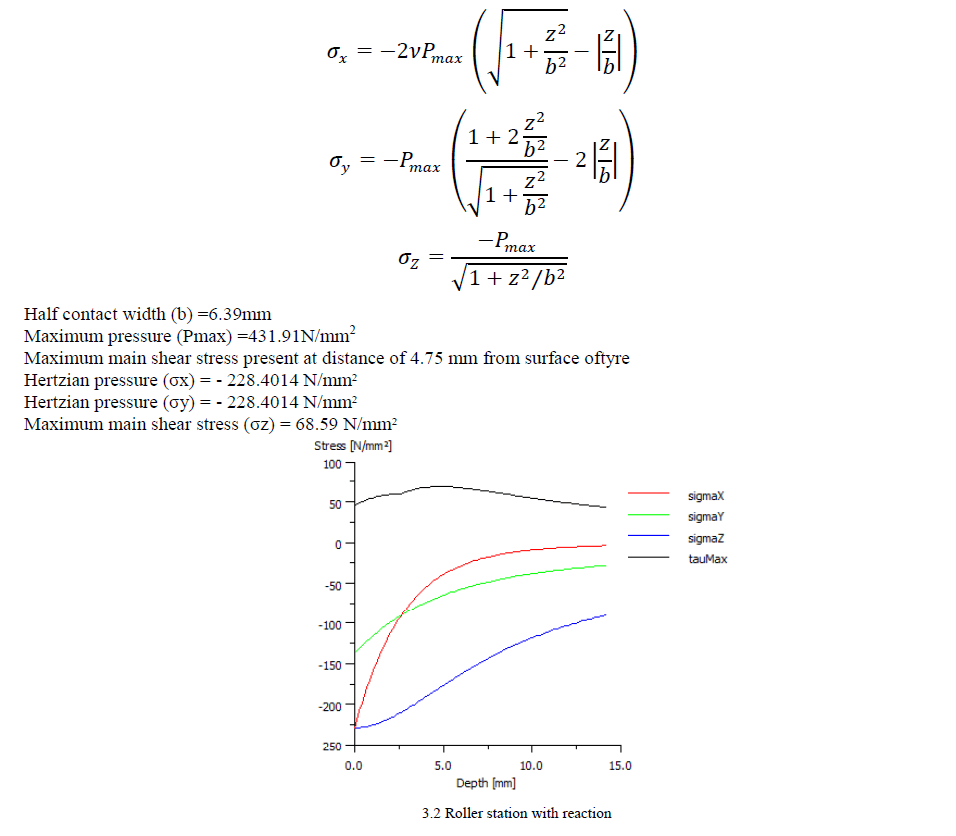 |
IV. TYRE & ROLLER CONTACT STRESS CALCULATION BY FEM |
| Tyre and roller is modelled in ABAQUS. Only half part of tyre and roller is considered. Both parts are considered of the steel and appropriate material properties are set in. Model is dense meshed at contact point. The problem is linear, and contact condition is modelled using contact pair approach. Contact property is friction less. |
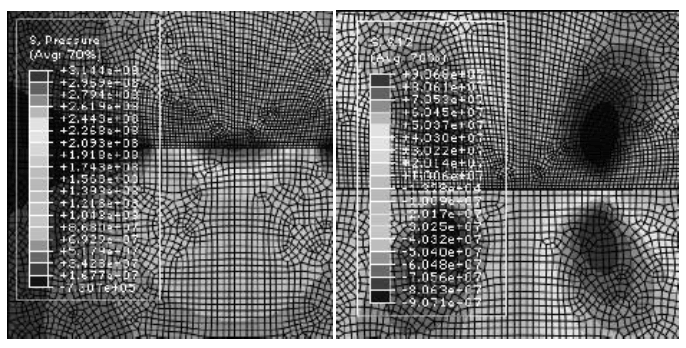 |
| Comparison between stress valves from analytical and FEM analysis:-Maximum pressure acts at middle of tyre width, as per FEM Pmax =344.4N/mm2 and as per analytical method Pmax =431.9N/mm2. Deviation is 20%.Maximum shear stress value is as FEM is σz= 90.68 N/mm2 and as per analytical method is σz= 68.59 N/mm2. Deviation is 32%. Allowable Hertzian pressure valve for tyre and roller is about 400 - 450 N/mm2. Calculated values using a simplified procedure is not far from it, suggesting that more detailed analysis is required. FEM proved to be good tool to get this. |
V. CONCLUSION |
| This paper presents analysis of contact stress between tyre and roller. Kiln is considered as simply supported beam. Kiln reactions are calculated by using STAAD soft ware. There is no much more difference in reactions at three tyres but maximum reaction is at third tyre. Contact stress is calculated by using hertz theory and FEM method. .Agreement between results from both methods is satisfactory. In order to find out more realistic condition, we have to consider dynamic and asymmetric loading, temperature effect, rolling contact. Maximum shear stress I not on contact surface but it is below the contact surface. |
References |
|